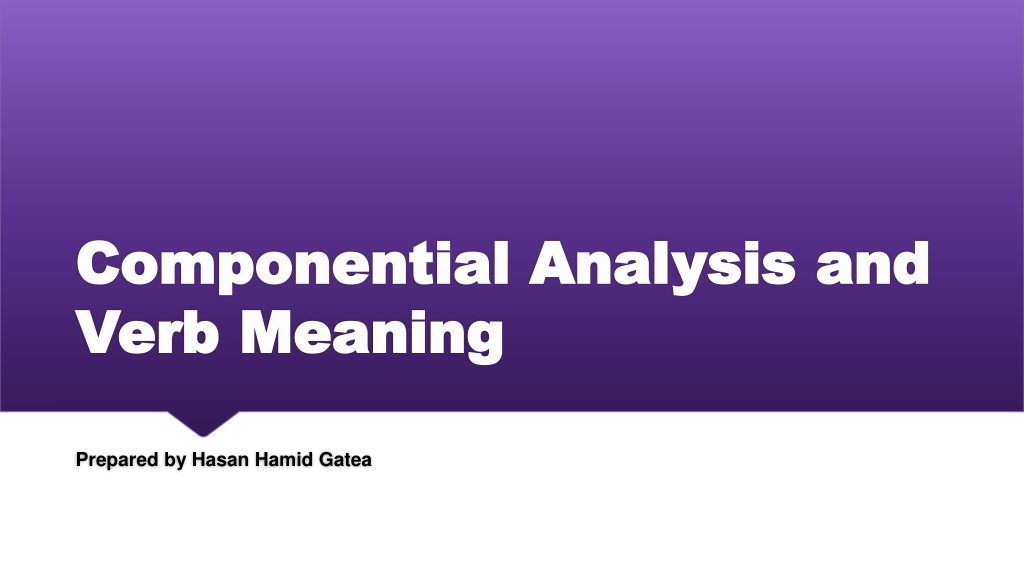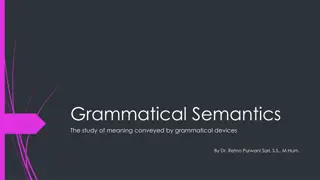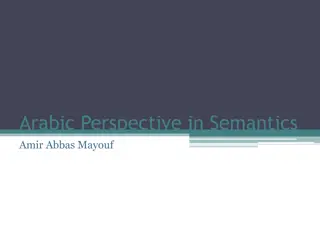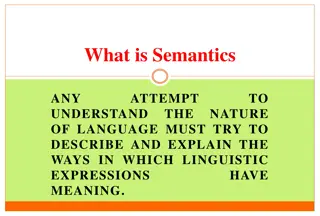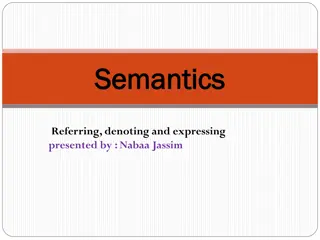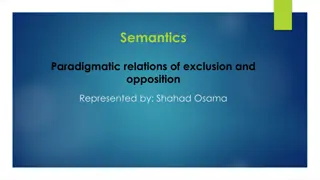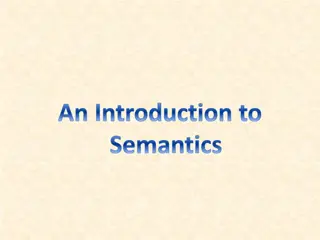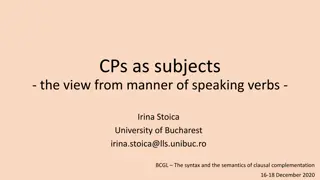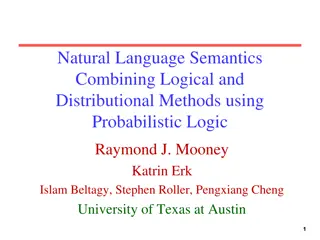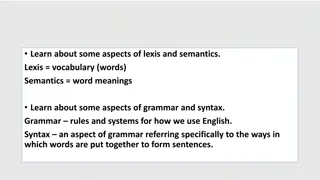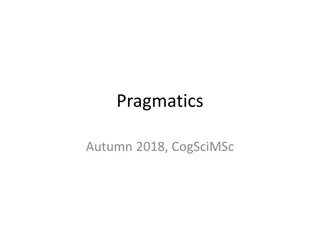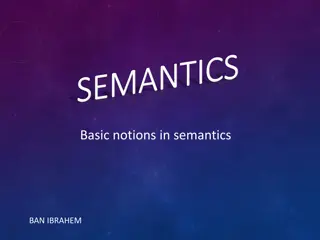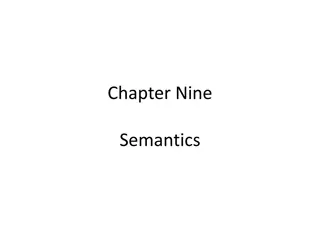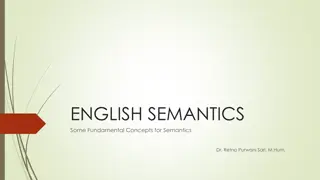Understanding Componential Analysis in Semantics
Componential analysis is a significant theory that emerged in the 20th century to analyze words based on semantic features. It helps identify word meanings by examining components and their features. This method involves representing features as either positive (+), negative (-), or unspecified (.). Through examples, such as gender and adulthood distinctions, the concept is illustrated. The theory explains sense relations like synonyms, complementary pairs, and hyperonyms. However, it faces challenges in defining gradable antonyms and other lexical distinctions. Despite some limitations, componential analysis contributes to understanding word meanings in semantics.
Download Presentation

Please find below an Image/Link to download the presentation.
The content on the website is provided AS IS for your information and personal use only. It may not be sold, licensed, or shared on other websites without obtaining consent from the author. Download presentation by click this link. If you encounter any issues during the download, it is possible that the publisher has removed the file from their server.
E N D
Presentation Transcript
Componential Analysis and Componential Analysis and Verb Meaning Verb Meaning Prepared by Hasan Hamid Gatea
Componential Analysis Componential Analysis Componential analysis is a very influential theory which emerged in the 20thcentury, it analyzes words through a set of semantic features within the words components to better identify the meaning of words. H. 2006, p. 20). (Ottenheimer,
Hjelmslev (1953) provided a famous example which created a motivation to this approach when he clearly demonstrated the gender is an aspect of meaning, which can distinguish pairs of lexical items within certain semantic domains; as illustrated in figure 1.1.
Since features therefore, they can be represented by either (+) if the feature applies to the semantic unit, or, (-) if the feature does not apply to the said unit, and, if the feature is unspecified it is then presented by ( ). An example for the unspecified feature is the adulthood of a human because a human can be a child or can be an adult. Below (figure 1.2) is an example of componential analysis based on gender and adulthood. like gender and adulthood are binary,
Componential analysis explains some sense relations, for instance, synonyms will share all semantic features of meaning, complementary pairs such as (alive, awake, legal) will differ only in polarity of one feature. Hyperonyms (for instance the word dog is a hyperonym for animal) are a subset of the semantic components of their hyponym (for instance the word poodle is a hyponym of the word dog), therefore, each hyponym contains all the semantic components of the hyperonym plus at least one extra component which distinguishes the meaning between them. It is not easy however to define the gradable antonyms, converse terms or meronyms using this method, due to a number of issues which emerged in regards to the binary feature approach as argued by Engelberg (2011) and Lyons (1977), these issues include:
Problems of Componential Problems of Componential analysis analysis First: binary features can not easily express a number of lexical distinctions, for instance, distinguishes the cat family (tigers, lions, leopard etc) they differ from each other in a number of distinctive features, therefore, we might need number of features as great as the lexical items themselves. the features that
Second: two-place predicts representation in binary features is unclear, for instance, the verbs recognize and offend: A- He recognized me. B- He offended me. In example (a) the affected argument is (he) because the subject experienced a change in state i.e. he became aware of the second argument. Whereas in example (b) the affected argument is (me) because the second argument experienced a change of state i.e. he became offended by the first argument. Therefore, we cannot specify which argument is affected using a simple feature matrix like in figure 1.1 and 1.2.
Third: some word meanings are impossible to be represented in features, matrix or not. For instance, a number of studies have been concerned with the semantic components of kinship terms in languages, in this field, a certain way of structuring components needed to be followed for instance mother s brother s spouse (one sense of aunt in English) would probably be different in other languages. Structured components seem to be necessary for verb meanings as well. For instance, want to cause to die is part of the meaning of murderous, while, cause to want to die is similar to one sense of mortify.
Fourth: within restricted semantic domains, the binary feature analysis can come in handy, however, a question might be raised as to how many features we may require to describe a full lexicon of a certain language? If we would to compare a wider range of words we might find ourselves needing a large inventory of features, which can be as big as or greater than the lexicon itself.
Verb meaning Verb meaning Since verb meanings can directly influence the syntactic structure of the sentence, and, since syntactic evidence is helpful in supplementing traditional semantic methods, thus, modern researches in lexical semantics payed special attention to verb meanings. Charles Fillmore (1970) introduced two classes of transitive verbs in English namely: Surface contact verbs: such as (hit, slap, strike, bump, stroke) Change of state verbs: such as (break, bend, fold, shatter, crack) Fillmore shows that members of each class share syntactic and semantic properties which distinguishes them from members of other class, furthermore, he states that there is a correlation between the syntactic and semantic properties which supports a view of lexical semantics.
The verb is made of two types of elements namely: 1- Systematic components of meaning shared by the entire class. 2- Idiosyncratic components specific to the individual root. Syntactic effects only assumed to occur in the second type. This insight has been the foundation for a deeper subsequent work in the field of verbal semantics. Additional criteria have been identified to make this distinction, one of which is known as the causative-inchoative alternation test.
causative causative- -inchoative alternation test. inchoative alternation test. Change of state verbs (break verbs) exhibits systematic polysemy between the transitive verb and an intransitive sense, as we see in the example below: A- Ali shattered the glass (with a hammer). B- The glass shattered. The intransitive sense has inchoative meaning (b) while the transitive sense has a causative meaning (a). Surface contact verbs (hit verbs) do not accept this alternation and usually lack the intransitive sense all together, as illustrated in the example below: A- Ahmed stroke the TV (with his hand). B- *The TV stroke.
Other tests Other tests The conative alternation Body-part possessor ascension: Ali hit the fly I hit his arm Ali hit at the fly I hit him on his arm I cracked the mirror I broke his leg *I cracked at the mirror *I broke him on the leg The middle alternation This window breaks easily *This window hits easily
These tests display high degree of convergence, a convergence which shows how members of each class share properties in common, which, Fillmore (1970: 125) suggests that these shared properties are semantic components. Fillmore then provides an evidence for this claim where he provides the following example: I hit the window with a hammer; it didn t faze the window, but the hammer shattered. *I broke the window with a hammer; it didn t faze the window, but the hammer shattered. Sentence (a) is acceptable, even if it surprising due to our shared awareness of the world around us, however, sentence (b) poses a contradiction.
We have to keep in mind that even if break verbs are all members of the change of state verbs, they don t share the same meaning. Each of the break verbs have their own distinctive meaning. Fillmore (1970: 131) adds that the only shared meaning has syntactic consequences, and that the idiosyncratic aspect of meaning of the break verbs for example, does not affect the grammatical realization of the argument.
Levin Levin Levin (1993) extends Fillmore s study of verb classes where she adds two other classes namely Touch verbs (touch, pat, stroke etc.) and Cut verbs (cut, hack, saw etc.), she further demonstrates the distinctive pattern of syntactic behavior of these verbs as in the following examples:
Cuts verbs and touch verbs Cuts verbs and touch verbs Conative alternation Body-part possessor ascension Ahmed touched the cat I touched Ali s shoulder. *Ahmed touched at the cat I touched Bill on the shoulder Margret cut the rope I cut Ali s shoulder Margret cut at the rope I cut Ali on the shoulder Middle: The bread cuts easily *cats touch easily
Levin summarizes these observations, stating that body-part possessor ascension is only possible for verb classes that are involved in surface contact, the connotative alternation is only possible for verb classes that include both contact and motion, middle alteration is only possible for verb classes that include a change in state, as summarized below: - touch verbs = contact - hit verbs = motion, contact - cut verbs = motion, contact, change - break verbs= change
Levin then went on to identify 192 English verb classes with 79 diagnostic patterns of diathesis alternation (which is the change in syntactical way of expressing arguments). Levin further adds that the ultimate goal is to understand meaning components, she argues that although not all meaning components are grammatically relevant (only those who share the same class are), the actual meaning that distinguished the verbs in the same class is idiosyncratic, syntactical behavior. which, does not affect the
Rappaport Hovav and Levin (1998: 109) introduced the lexical decomposition theory as a formula to partially represent the systematic components of meanings for verbs, where (x) represents the agent and (y) represents the patient, and, the idiosyncratic aspects of meaning for a verb would be associated with the state predicate (for example if the verb is break then the state predicate is broken ) [[Xact] CAUSE [BECOME [y<state>]]]
